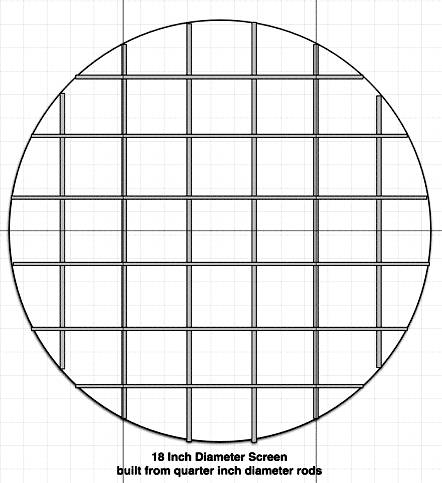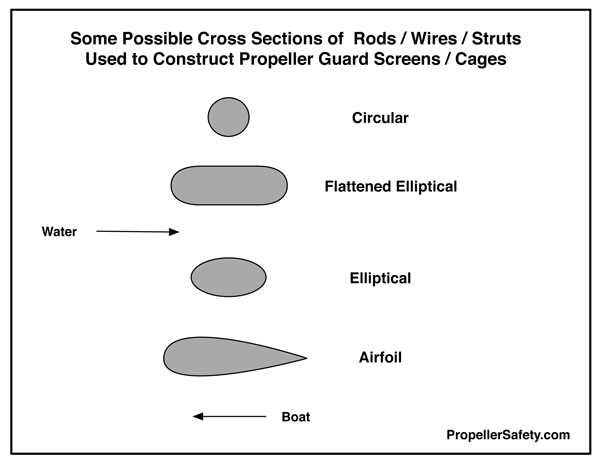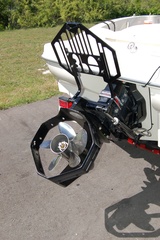Propeller Guard Drag Research Projects – Senior Design Projects
Boat propeller guards create drag which effects the performance of the boat, especially the top speed attainable at wide open throttle and time to plane. Propeller guard designers try to minimize drag by increasing the size of the mesh (make the open holes larger) and by decreasing the size of the wires / rods used to construct the mesh. However, those actions begin to reduce protection provided by the propeller guard, its rigidity and its strength. Prop guard designers make these tradeoff without an in depth understanding of all the variables involved.
We propose further research by students as Senior Design Projects, Sr. Thesis, Masters Thesis, and Capstone projects on the drag created by the components (meshes, screens, wire, rods, struts) used to construct propeller guards in clean flows and in the turbulence present in their operating environment.
Specific areas that propeller guard designers especially need a better understanding of drag include:
- The drag created by meshes of round rods, wires, or struts used in propeller guards. In addition to the drag of these elements in regular flows at boating velocities, we need to understand the drag they create in very turbulent conditions near the propeller in which they operate. The propeller has a jetted output that also pulsates with propeller blade rotations. Plus some meshes are in low pressure suction areas, while others are downstream of the propeller. In addition, some areas of the mesh are at an angle to the oncoming water.
- The drag created by meshes and screens composed of wires, rods, or struts of other cross sectional shapes (elliptical, flattened elliptical, etc.)
- The drag created by meshes and screens composed of wires, rods, and struts of air foil cross section, and of other hydrodynamic direction dependent shapes. In addition, there are some applications in which direction dependent hydrodynamic shapes might be employed in propeller guards in the opposite direction than one would normally think. For example, the flip up shield of Guy Taylor’s Navigator 3PO propeller guard. The shield is only down in reverse. Directional dependent hydrodynamic shaped rods, wires, or struts used to construct his shield could be installed to provide reduced drag in reverse.
- Drag associated with the specific method of weaving rods or wires together to form a mesh (formed flat, one direction on top of the other, plain square, full twill, semi-twill, plain dutch, twilled dutch, etc.) and which weaves create the least drag in propeller guard applications while still meeting strength requirements.
- Drag created by vertical or horizontal vanes arranged to protect people from entering the propeller.
- The possibility of reaping the dip in drag coefficients at certain Reynolds Numbers as described in our Propeller Guard With Reduced Drag invention disclosure in some propeller guard application. This may allow designers to use larger wires and rods while achieving lower drag in certain situations.
- The impact of surface roughness of the rods and wires on drag. Do we want to polish them up, or rough them up to speed the onset of turbulence and reduce drag. How much of a difference does it make in the propeller guard environment that is already very turbulent?
- Drag currently created by various propeller guards at different speeds. For example, chart the drag associated with some of the guards shown on our Propeller Guard Design Trade Offs page. Can we really build them up from their components and calculate similar drags? We suggest coast down drag testing as a quick place to begin. We have been working on a paper on this technique for about 15 years and still not finished it. We hope to get posted on PropellerSafety.com sometime in 2012. If somebody wants to do work in this area sooner, please contact us.
Propeller guard designers need some tools, rules of thumb, design charts, and other aids to help them select the optimum cross sectional shapes, rod sizes, mesh sizes, and weaves for their designs that also minimize drag. We recognize the propeller guards will need further testing, but we need to help them get in the ballpark faster.
We are publishing this research project in an effort to attract Senior Design Students, Capstone projects, Masters Thesis projects, and others seeking a research project. We anticipate the projects might appeal to students in mechanical engineering, fluid power, safety, law, legal, design, ocean engineering, naval engineering, human factors, and other areas. Tools that might be employed include Computational Fluid Dynamics (CFD), flow channels, numerical modeling, particle image velocimetry (PIV), laser doppler velocimetry (LDV), scale modeling, force scales, and test runs of pushing water past a screen/cage suspended in the water.
If anyone is interested in doing work in this area, please contact us.
Propeller Guard Drag Background Information
A major objection raised against conventional duct or cage type propeller guards is they increase drag. Those objecting to the use of conventional propeller guards say the increased drag:
- Reduces the maximum top speed attainable by the boat
- Requires a larger, heavier, higher horsepower engine to achieve the same top speed
- Lengthens time to plane (takes longer for boat to get up on plane)
- Increases fuel consumption
- Increases emissions
- May prevent the vessel from getting on plane
- May prevent rescue vessels using them from reaching an emergency in time to save people or from returning to shore fast enough to save the injured they rescued
These objections have slowed the adoption of conventional propeller guards.
Propeller guard design involves making a large number of trade offs (see Propeller Guard Design Trade Offs). Propeller guard designers are currently making those decisions without a complete understanding of their impact.
Basic Math Behind the Drag of Screens
Many say the pressure drop across the screen is related to the drag created by a row of cylinders by a pressure drop coefficient K. They are basically saying you could just reduce the screen to its cylindrical components (the wires) and treat them as long cylinders. Calculate the drag for the wires, then adjust that using the pressure drop coefficient K (sometimes called a drag coefficient).
K is highly tied to the solidity ratio of screen (ratio of the closed area to the total area of the screen).
Bibliography of The Study of Propeller Guard Meshes and Screens
Much work has been done on meshes in other fields, typically tighter meshes at low flow rates in air. Most of the in-water research was done with fishing nets or towed fish cages, cooling system intake screens to keep fish out, and fish exclusion screens in front of dams or other obstacles. Most of the in water testing has been done at slower velocities than those present in boating and in less turbulent flows. We present a brief annotated bibliography below.
- Flow Through Woven Screens. James C. Armor and Joseph N. Cannon. American Institute of Chemical Engineering. Vol.14. No.3. Pgs.415-420. May 1968. This is the landmark paper most others build upon.
- Prediction of Pressure-Drop For Incompressible-Flow Through Screens. Brundrett. Vol.115. No.2. Pgs.239-242. New pressure loss correlation on up into higher Reynolds Numbers also allows calculations for non-perpendicular flow and investigates shape of the wires, and local damage to them, and tension on the screen.
- Computational Simulations of the Wind-force on Metal Meshes. Sharifian and Buttsworth, both of Australia. 16th Australian Fluid Mechanics Conference. Gold Coast Australia. 2-7 December 2007. Discusses wind forces of meshes used in security screens, sports grounds, and used there to protect building from blowing embers in fire prone areas.
- Simulation of the Flow Through Woven Fabrics. Green, Wang, Waung, Vakil. Computers and Fluids. Vol.37. (2008) Pgs.1148-1156. Page 1153 illustrates the velocity contours for finer meshes.
- Measurement and Correlation of Hydraulic Resistance of Flow Through Woven Screens. Wu, Liu, LI, Hsieh, all of Taiwan. International Journal of Heat and Mass Transfer. Vol.48. (2005) Pgs.3008-3017. Charts on page 3012 extends the previously observed correlations up to higher Reynolds Numbers.
- Development of a Porous Media Model With Application to Flow Through and Around a Net Model. Patursson, Swift, Tsukrov, Simonsen, Baldwin, Fredriksson, Celikkol. Ocean Engineering. Vol.37. (2010) Pgs.314-224. Fish cages used in rivers or the ocean for aquaculture are towed to new sites from time to time. The authors tried to extend the porous media model to model the drag of these aquaculture fish cages.
- Analytical and Experimental Investigation of Drag on Nets of Fish Cages. Zhan, Jia, Li, Sun, Guo, and Hu. Aquacultural Engineering. Vol.35. (2006) Pgs.91-101. A study of the drag of fish cages constructed from nets.
- Aquaculture Net Drag Force and Added Mass. Balash, Colbourne, Bose, and Raman-Nair. Aquacultural Engineering. Vol.41. (2009) Pgs.14-21. Introduces the topic of Added Mass often discussed in propeller injury trials. When a person moves in the water, some water moves with them, effectively increasing their mass, and thus increasing their resistance to movement or currents. The same thing happens with fish cages.
- Characterizations of Geometry and Normal Drag Coefficients of Copper Nets. Tsukrov, Drach, DeCew, Swift, Celikkol. Ocean Engineering. Not yet published, available via Science Direct. Copper netting is used in aquaculture for its strength and to reduce biofouling. As shown in this study, they also significantly reduces drag.
- Hydrodynamic Effects on Flow Through Screens at Intakes. Alsaffar. Water Research. Vol.8. No.9. (1974) Pgs.617-622. Investigates both pressure drop and deviations in flow and the water goes around the screen. Intake screens are perhaps more similar to propeller guards in screen size and flow rates than the other in-water research areas (seines, fish nets, aquaculture fish cages).
- Free Surface Flow Through Screen. Journal of Hydraulic Engineering. Vol.115. No.10. Pgs. 1371-1385. Yeh and Shrestha. Predicts headloss from screens in a channel at an angle to flow. Finds optimal angle to minimize head loss. Has fish exclusion screen applications.
- Fish Diversion in a Hydropower Intake. Odgaard, Cherian, Elder. Journal of Hydraulic Engineering. Vol.113. No.4. (1987) Pgs. 505-519. Fish intake screens.
- Hydrodynamic Modeling Study of a Fish Exclusion System for a River Diversion. Coonrod, Hanna, and Mefford. River Research Applications. Vol.27. (2011) Pgs.184-192. Tests several different screens at different flow rates.
- On the Experimental Study of the Flow Around a Fishing Net. Pichot, Germain, and Priour. European Journal of Mechanics B/Fluids. Vol.28. (2009) Pgs. 103-116. Studies the flow inside and around a commercial trawler net. Some of techniques and the streamline charts may be useful in visualizing flow around propeller guards.
Some other papers you may find helpful are:
- Turbulence and Reynolds Number Effects on the Flow and Fluid Forces on a Single Cylinder in Cross Flow. Norberg and Sunden. Particularly studies turbulent flow around cylinders (like wires or rods).
- Turbulence vs. Drag – Some Further Considerations. Bell. Collects data on turbulent flow around cylinders and investigates the change to turbulent flow, including the Tollmien-Schlichting (T-S instability mechanism).
- Prop Buddy: The Next Generation Propeller Guard. Nakamura, Chaney, and Roberts. A 1998 Marine Field Project by three Florida Institute of Technology Marine Environmental Systems students. They designed and conducted an experiment to optimize the design of the ring of the Prop Buddy propeller guard. Their techniques could be extended to many of the questions asked surrounding mesh sizes, wire sizes, and wire cross sections.
We suggest some keywords below for those who may wish to search further:
- Screen, mesh, net, seine, fishing net, weave, woven, grid, porous membrane
- fish cages, aquaculture
- intake screens
- drag, resistance, pressure drop
- solidity ratio screens


